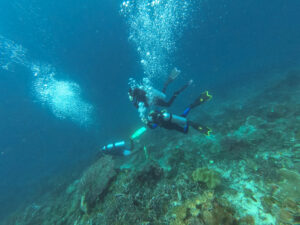What Are Open Heel Fins?
Open heel fins are a type of swimming fin used primarily in scuba diving. They are designed with an open area at the heel, which is secured with an adjustable strap. This design contrasts with closed heel fins, which fully enclose the foot like a shoe. The open heel configuration allows for a more flexible fit, making them ideal for use with neoprene boots, which provide thermal protection and additional comfort. The ability to adjust the fit is particularly beneficial for divers who need to accommodate varying thicknesses of dive boots or who require a custom fit for optimal performance and comfort.
Historical Development of Open Heel Fins
The evolution of open heel fins is rooted in the broader history of swimming aids, which dates back centuries. Early iterations of swim fins were rudimentary and often crafted from natural materials like wood or leather. These early designs were more akin to paddles than the sophisticated fins we see today. The need for efficient underwater propulsion drove the development of more advanced designs, particularly in the mid-20th century when scuba diving began to gain popularity as a recreational activity.
One of the pivotal moments in the development of open heel fins came with the invention of modern rubber fins. The increased flexibility and durability offered by rubber significantly improved the performance of fins. The introduction of adjustable straps marked another significant advancement, allowing for a more customizable fit and greater versatility in different diving conditions. This innovation was a game-changer, as it enabled divers to use fins with various types of footwear, such as neoprene boots, which became standard for thermal protection in colder waters.
As scuba diving technology continued to evolve, so did the materials and design of open heel fins. The advent of advanced polymers and composite materials in the late 20th and early 21st centuries further enhanced the efficiency and comfort of these fins. These materials allowed for lighter, more durable fins that could withstand the rigors of frequent use in diverse underwater environments. Today, open heel fins are an essential piece of equipment for divers around the world, thanks to their adaptability, performance, and the historical innovations that have shaped their development.
Design and Features of Open Heel Fins
Open heel fins are characterized by their distinctive design, which includes an open area at the heel and an adjustable strap system. This design not only allows for a customizable fit but also provides the flexibility to wear the fins with different types of footwear, most commonly neoprene boots. The adjustable straps are typically made from durable materials such as rubber or silicone and often feature quick-release buckles for easy donning and doffing.
The blade of an open heel fin is a critical component that significantly influences its performance. Blades are typically made from materials like plastic, fiberglass, or carbon fiber. Each material offers different benefits; for example, plastic is lightweight and affordable, while fiberglass and carbon fiber provide superior strength and flexibility. The design of the blade itself can vary, with some fins featuring vents or channels to optimize water flow and reduce drag. This allows divers to move through the water with greater efficiency, conserving energy and extending their bottom time.
Another important feature of open heel fins is the foot pocket, which houses the diver’s foot and transfers the force generated by the leg kick to the blade. Foot pockets are often ergonomically designed to provide comfort and support, reducing the risk of foot cramps and blisters during long dives. The combination of a well-designed foot pocket and an efficient blade is what makes open heel fins particularly effective for scuba diving. They offer the right balance of power and maneuverability, allowing divers to navigate various underwater environments with ease.
Advantages of Open Heel Fins in Scuba Diving
Open heel fins offer several advantages that make them a preferred choice for scuba divers. One of the primary benefits is the enhanced propulsion they provide. The design and materials used in these fins allow for more efficient movement through the water, which is particularly important when diving in strong currents or covering large distances. The ability to generate more power with each kick means that divers can move more quickly and with less effort, conserving energy and extending their dive time.
Another significant advantage of open heel fins is their adjustability. The adjustable straps ensure a secure and comfortable fit, which is crucial for maintaining control and stability underwater. This is particularly beneficial for divers who wear neoprene boots for thermal protection, as the straps can be adjusted to accommodate different boot thicknesses. This flexibility also means that open heel fins can be used in a variety of water temperatures and conditions, making them a versatile choice for divers who frequent different dive sites.
Open heel fins are also known for their durability. The materials used in their construction, such as high-quality rubber, silicone, and composite materials, are designed to withstand the harsh conditions of the underwater environment. This includes exposure to saltwater, UV rays, and physical impacts. As a result, open heel fins tend to have a longer lifespan compared to other types of fins, providing divers with a reliable piece of equipment that can be used for many years. Additionally, the ease of maintenance and the availability of replacement parts, such as straps and buckles, further contribute to their longevity.
Types of Open Heel Fins
There is a wide range of open heel fins available on the market, each designed to meet the specific needs and preferences of different divers. One of the key factors that differentiate these fins is the material used in the blade. Plastic blades are common in entry-level fins due to their affordability and lightweight nature. These fins are ideal for beginner divers or those who engage in occasional recreational diving. They offer a good balance of performance and cost-effectiveness, making them accessible to a broad audience.
For more experienced divers or those who require higher performance, fiberglass and carbon fiber blades are popular choices. These materials provide greater strength and flexibility, resulting in better propulsion and maneuverability. Fiberglass fins are often favored for their durability and consistent performance, while carbon fiber fins are prized for their lightweight and superior responsiveness. These high-performance fins are ideal for technical divers or those who engage in more challenging dives, such as deep dives or dives in strong currents.
Another type of open heel fin that has gained popularity in recent years is the split fin. Split fins feature a unique blade design with a split down the middle, which reduces drag and increases efficiency. This design mimics the natural movement of marine animals, providing a more effortless kick and reducing strain on the legs. Split fins are particularly beneficial for divers who suffer from joint pain or fatigue, as they require less effort to generate propulsion. They are available in various materials and designs, catering to different levels of diving experience and personal preferences.
Usage Guidelines
Selecting the right size and fit for open heel fins is crucial for both comfort and performance. Divers should ensure that the foot pocket fits snugly around their feet without being too tight, as this can cause discomfort and lead to foot cramps. It is also important to consider the type of footwear that will be worn with the fins, such as neoprene boots. The fins should accommodate the boots comfortably, with the adjustable straps providing a secure fit. Many manufacturers provide sizing charts and guidelines to help divers choose the correct size based on their foot measurements and the thickness of their boots.
Proper maintenance and care are essential to extend the lifespan of open heel fins. After each dive, fins should be rinsed thoroughly with fresh water to remove any salt, sand, or debris that could cause damage. It is also important to inspect the fins regularly for any signs of wear and tear, such as cracks in the blade or worn-out straps. If any parts are damaged, they should be replaced promptly to prevent further deterioration. Storing the fins in a cool, dry place away from direct sunlight will also help preserve their condition.
Using open heel fins effectively requires proper technique. Divers should practice a steady and controlled kick, ensuring that their legs are moving in a smooth, coordinated manner. This not only maximizes propulsion but also minimizes the risk of fatigue and cramping. It is also important to avoid excessive kicking, as this can disturb marine life and stir up sediment, reducing visibility. By following these guidelines and practicing good diving habits, divers can make the most of their open heel fins and enjoy a more comfortable and efficient underwater experience.
Technological Advancements
Recent years have seen significant technological advancements in the design and materials of open heel fins. One of the most notable developments is the use of advanced composite materials, such as thermoplastic elastomers (TPE) and carbon fiber composites. These materials offer a unique combination of strength, flexibility, and lightweight properties, enhancing the performance and comfort of open heel fins. TPE, for example, provides excellent resistance to wear and tear, while carbon fiber composites offer superior rigidity and responsiveness.
Innovations in blade design have also contributed to the improved performance of open heel fins. Many modern fins feature channels, vents, or other hydrodynamic features that optimize water flow and reduce drag. These designs allow divers to move more efficiently through the water, conserving energy and increasing their overall speed. Some fins also incorporate adjustable blade angles, which can be fine-tuned to match the diver’s kicking style and the specific conditions of the dive. This level of customization ensures that divers can achieve the best possible performance regardless of the environment.
Another significant advancement is the integration of ergonomic features into the foot pockets and straps of open heel fins. Manufacturers have focused on creating more comfortable and supportive designs that reduce the risk of foot cramps and blisters. This includes the use of softer, more flexible materials in the foot pocket and the addition of padding in key areas. Adjustable straps have also been improved with features like quick-release buckles and micro-adjustments, allowing divers to achieve a precise and secure fit with minimal effort. These technological advancements have made open heel fins more user-friendly and effective, enhancing the overall diving experience.
Key Takeaways
Open heel fins are an essential piece of scuba diving equipment, offering numerous advantages in terms of adjustability, performance, and durability. Their historical development reflects significant innovations in design and materials, leading to the high-performance fins available today. With a variety of types and features, open heel fins cater to divers of all levels and preferences. Proper usage and maintenance are crucial for maximizing their lifespan and performance. Technological advancements continue to enhance the functionality and comfort of open heel fins, making them an indispensable tool for divers worldwide.

















